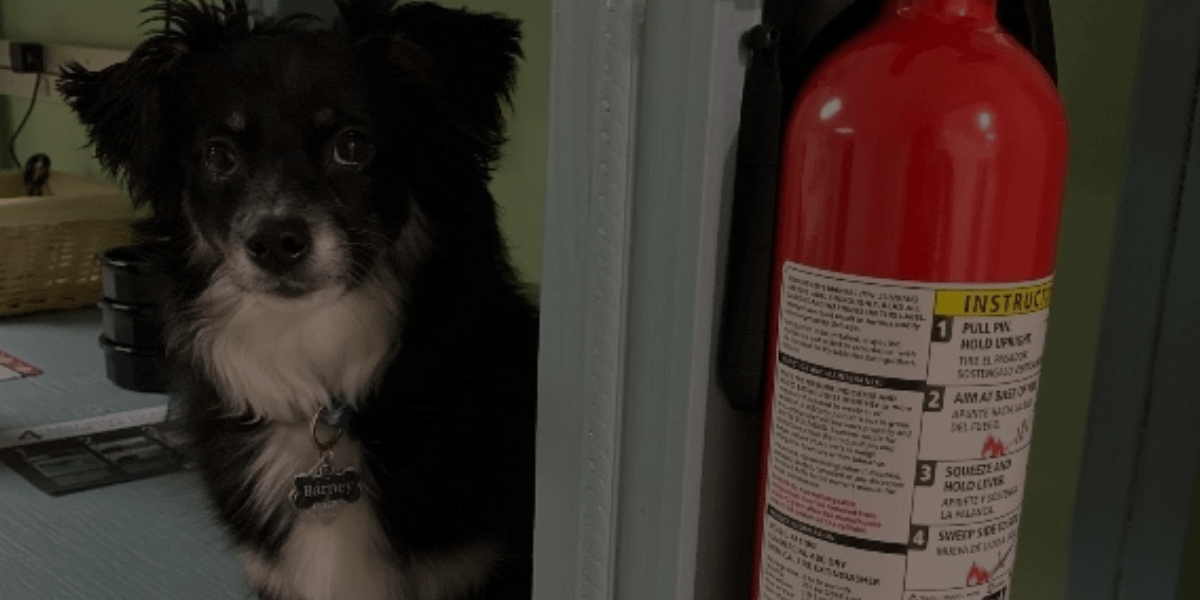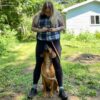Dog grooming professional, April Costigan, is a graduate of QC Pet Studies. To learn more about April, check out her Graduate Feature here.
Safety in the Workplace
Safety in the workplace is always the highest priority for a successful operation. In the world of dog grooming, this is especially true. Working with a wide variety of dog breeds means working with a wide variety of personalities, temperaments, and behaviors.
QC Pet Studies’ Dog Grooming Course
As part of QC Pet Studies’ Dog Grooming Course, there is an excellent section called, Personal Health and Safety. This section thoroughly discusses how to keep yourself healthy and safe while working as a groomer. Although I’ve already graduated and am now working in the professional world, I still keep this particular booklet handy for easy reference.
The Personal Health and Safety booklet includes vital information regarding safety in a grooming environment. It talks about the significance of personal safety equipment – including those medical-grade masks that we’ve all become accustomed to wearing, thanks to COVID-19. Not only do these masks provide protection from airborne pathogens, such as viruses and bacteria; they’re key to keeping hair, dander, and dust out of your lungs.
QC’s tutorial further discusses clean air, toxic cleaning products, and even shampoos that contain toxins. (You know, the ones intended to kill fleas and ticks.) The Lesson Guide is one of my favorite course materials to reference from time to time, as it also gives advice and suggestions on how to protect your hearing and keep your body physically fit for grooming.

My Top 3 Safety Tips When Working in a Dog Grooming Salon
The following are tips and tricks that I have established and utilize in my own shop…
1 – Technique
Most groomers develop their own style while working with dogs. They might adopt positive techniques that help benefit them, the dog, and their overall performance. For instance, I know one dog groomer who hums the entire time she grooms. She finds that it keeps her focused. Plus, she says it calms her dogs.
Personally, I cannot carry a tune to save my life. As such, I do not hum to my dogs. However, I do speak in a calm, low voice when the dog on my table seems anxious or nervous. This mostly happens when trimming nails or dealing with difficult mats. I am gentle but persistent when completing these tasks.
On the flip-side, there are also techniques that groomers can adopt that are not all that safe. At a large retail store, for example, I observed a groomer who would force an animal into submission in order to trim their nails. I found this alarming! In my opinion, that sort of technique isn’t necessary. In the dog grooming industry, there’s no room for a bully. Not to mention, this groomer will always run the risk of the dog reacting in self-defense and becoming aggressive.
Whenever I deal with a fussy dog who hates getting his nailed trimmed, I’ll employ patience. First, I’ll trim as many nails as the dog will allow before getting too upset. Then I’ll simply change to a different, more soothing task for the time being, such as brushing or ear cleaning. Once the dog has sufficiently settled down, I can trim a few more and return to the more soothing task whenever necessary.
Proper technique and etiquette may take longer, but it’ll always be worth it in the end. It’s also the path that will keep all parties involved the safest.

2 – Preventing Bites
As a dog grooming expert, there will be times where your client’s dog will attempt to bite you. This just comes with the territory of working in this field. The risk is real, so you must be able to anticipate when a dog becomes so agitated that they may try to bite you.
In this kind of situation, muzzling the dog may be the only choice. The Groomer’s Toolkit lesson, taught by QC Pet Studies, does a great job in talking about a variety of tools you’ll be using in the workplace. Muzzles and E-collars are discussed on page 28. Keeping a First Aid kit on-hand is also a must! Personally, I’ve had to crack open the bandages on more than one occasion.
To drive this tip home, I’ll tell you a little story…
Story Time!
I once had a client named Spike. He was adopted from the shelter I work at, and he’s known for being a very nice dog. However, Spike had a traumatic history. As a result, he would turn into a biting dog whenever he became insecure.
He had bitten several people in his lifetime. In fact, I’ve seen this in action myself. He even gave me a very superficial bite when we first met. During his time at the shelter, we became good friends. Eventually, I was the only one who could successfully fit him for a muzzle when he needed medical care (which was often, as he had some medical issues).
When he finally left the shelter as a foster dog, he became a regular client of mine. Whenever he came to my home studio, I’d take some extra precautions to protect myself from what I fondly called, “Spike bites”.
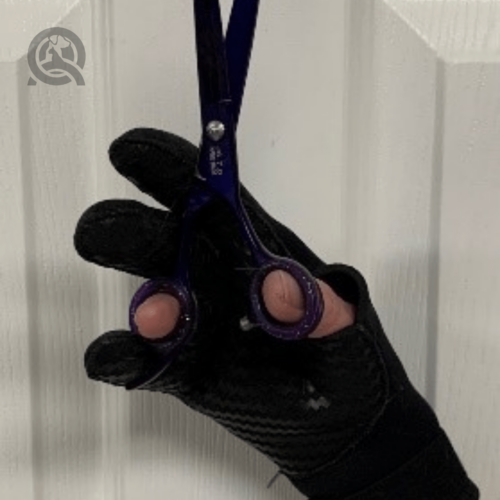

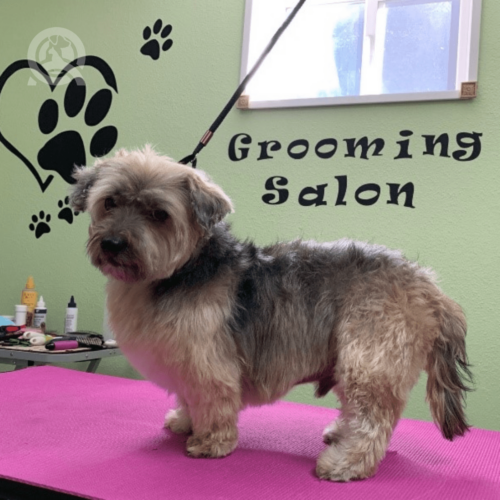
Preventing “Spike Bites” in My Dog Grooming Salon
First, I purchased a muzzle that would fit him comfortably. I only used it when it was absolutely necessary, which was during nail trims. He actually loved to be groomed and was an easy dog to work with – once you got past the nail trim.
Secondly, I made myself my own bite-proof gloves. I bought a pair of scuba-diving gloves and cut the thumb and ring finger off. The fabric that wetsuits and scuba gloves are made of is very strong. So strong, in fact, that Spike could not penetrate it. And trust me, he tried more than once!
By cutting the thumb and ring finger off, I was able to easily use my scissors when trimming around Spike’s face. Sadly, sweet Spike has passed on, due to his medical issues. But I will always be grateful for the lessons he taught me about preventing bites. I still actually call my gloves, “Spike’s Gloves”, so I won’t ever forget him.
3 – Fire Safety
Every business, home, and maintained structure has fire prevention strategies. It’s just part of our world. In a dog grooming salon, this is no different. Ensuring that you are prepared for a fire emergency is essential!
Of course, we all hope that we’ll never experience this sort of problem. But if you aren’t prepared for one and one actually occurs, it will have devastating results. There is a lot of electrical equipment in a dog grooming shop. Common examples are clippers, dryers, laundry equipment, vacuums, air purifiers, dehumidifiers, and maybe even radios.
I safeguard my workspace by regularly checking cords, electrical outlets, and the equipment for any wear and tear or fire-causing mediums. Furthermore, there are no flammable liquids kept in my studio. For that added bit of extra precaution, I also keep TWO fire extinguishers available in my work areas. If you plan to do the same, just make sure that they’re easy to reach in the event of an emergency.
PRO TIP: Have a Planned Escape Route in Your Dog Grooming Salon!
In my dog grooming salon, I also have more than one planned escape route, as well as a system for getting my dogs to safety. Please note that having a fire extinguisher and knowing how to use it are two completely different things. To ensure that you’re truly ready, I suggest having a mock-fire emergency.
When I did this, I used a dog named Barney as my test dog. I had him in the tub. We then ran through a couple different scenarios involving a fire emergency. This way, I could make sure I knew how to get him out of the tub and run him to safety before attempting to use the fire extinguisher.
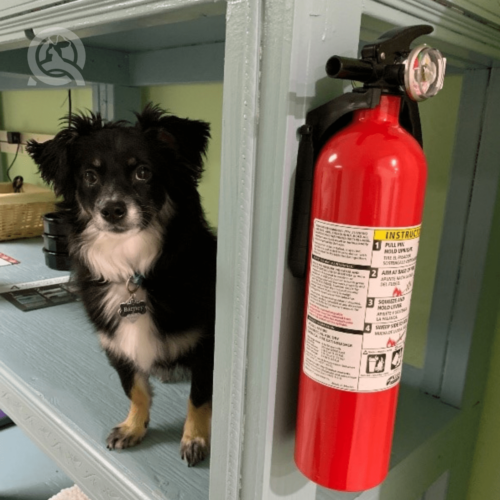

A wet, shampoo-soaked dog is a lot better than a deceased dog. I even pretended that I didn’t know how to use the extinguisher! This way a very great training exercise. In particular, this taught me how to keep calm and use every precious second to read the directions and follow them through. In a real emergency, it’s important to keep a cool head. Being able to do things carefully and quickly could be the very thing that saves your life.
There is no harm in practicing your plan and refining it when you find better ways to respond in an emergency. It’s my opinion that if I expect the unexpected, I’ll be better prepared to handle any emergency.
